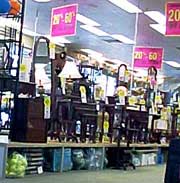
Manage Sales and Service Delivery
Using Sales Information
Sales figures are an essential element of measuring the store's performance but their usefulness is limited if used on their own. To be effective, they must be used with other productivity measures such as:
|
There is a marked difference between sales, gross profit and net profit/loss. That is why you should always consider the cost of selling your product in terms of the:
- Cost of stock
- Shrinkage due to mark-downs
- Overheads of running the business
How this sales data is collected, interpreted and communicated depends on the policies, procedures and practices of your store.
As a manager,
it is worthwhile speaking to the people who collect this information,
so you have a clear understanding of the process.
 |
| Sales records provide valuable information when evaluating product performance or planning sales promotions. |
Sales Records
Although sales records are normally confidential, often sales data is available to sales staff and could include:
|
Usually the company policy will state how this information is disclosed and who should have access to it.
For example, staff may receive a copy of their individual or total department sales. While this gives them an indication on how they are performing, it provides limited information on the overall profitability of the department.